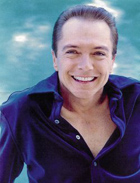
David Cassidy on the Web
In a Houston Penthouse With David Cassidy: Doing The "Shrimp Shuffle" in 1975
Promoting his first post-Partridge solo album, I was the only one in the room who didn't ask about "The Partridge Family." He was impressed.
February 10, 2022
By Brad Kyle
https://bradkyle.substack.com
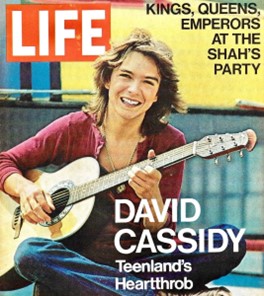
He was 25 years old, which is astounding to realize when you think about the worldwide fame he had accrued in the four years that millions of TV sets and turntables were tuned to all things Keith Partridge and his fictional family.
I was 20 at the time (mid-summer 1975), and as Music Director of the University of Houston radio station, KUHF-FM (with a daily 3-hour afternoon on-air shift), I was invited by the local RCA Records sales rep to attend a press confab at his Houston hotel’s (The Whitehall, maybe?) penthouse suite.
David Cassidy would be holding court with about half-a-dozen members of the local print press and other media types to tub-thump his debut solo LP for RCA, The Higher They Climb, the Harder They Fall, released in July 1975.
Some Cassidy Time Context
Cassidy, who passed away in 2017 at age 67 (this writer’s current age) was swept up into a media whirlwind few fifty-year-olds could weather, much less a 20-year-old. About a year before he and I met, his world came crashing down during a gate stampede at a London stadium show in May 1974. Nearly 800 people were injured in a crush at the front of the stage, and thirty were taken to the hospital, with one teenage girl passing away from injuries suffered in the surge.
Understandably fed up with all the media hype, hubbub and inconceivable consequences, David cut ties with Screen Gems and Executive Producer, Bob Claver. Created for TV by Bernard Slade, The Partridge Family, inspired by and loosely based on real-life pop-singing family, The Cowsills, ran for four years on ABC-TV, from September 1970 through August 24, 1974.
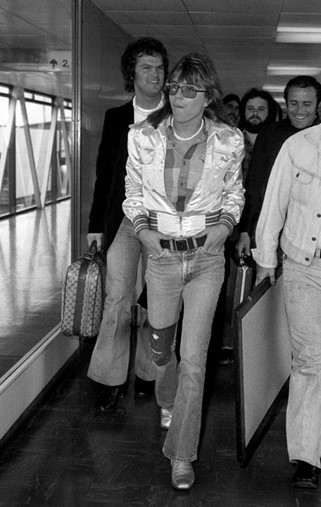
David arrives at London’s Heathrow Airport with entourage, May 1974. He’s just hours away from the horrific concert stampede that forced him to reassess his career. Fourteen months later, he’d record his first post-Partridge album and do a press tour that would bring him to Houston. Eagle-eyed fashionistas will note Dave’s spot-on circa-‘74 dress: Shag, tinted aviators, pukas, satin baseball jacket, and bell-bottomed hip-huggers with boots.
“The Higher They Climb……”
Cassidy, a guitar player, was a huge fan of rock guitar heroes, including Jimi Hendrix, Eric Clapton, and Led Zeppelin’s Jimmy Page, and was a devoted fan of hard rock.
As he told PopEntertainment.com in 2010: “I had played in blues bands, very different from Partridge Family music. I had seen Hendrix four or five times. I saw Clapton and Cream. I was an enormous Beatles fan. I had seen the Stones at the [L.A.] Forum in ’68. I was a big BB King and blues fan. That was the music that was in my generation as a teenager.”
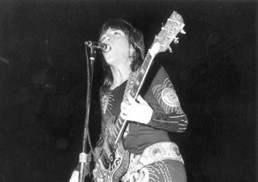
After being saddled with the teenybopper pop of his TV family, you’d think he would be more than anxious to pull out his guitar, a Marshall stack, and turn it up to 11 for his first post-Partridge album when he was free to record what and how he wanted! Nope.
He actually asked a bunch of Beach Boys and their cohorts to create a very pop-forward record. In fact, Beach Boy Bruce Johnston co-produced The Higher They Climb with David. The album failed to chart in the US, but with David already massively popular in the UK, it reached #22 on the British charts.
The Room
David was sitting in an overstuffed chair in what was the penthouse’s living room. A coffee table was in front of both him and my couch to his right, shared by another reporter and myself. I wish I could remember the room’s color scheme (possibly red and gold) and what David was wearing.
I had placed the station’s reel-to-reel tape recorder on the coffee table, and pushed “record” with David’s permission.
I had no intention of transcribing from the tape to print the contents of the interview. The only reason I brought the machine was to get a station ID from him, which I did at the end of our time together: “Hi, this is David Cassidy, and you’re listening to Brad Davis (my air name) on KUHF-FM Radio,” he dutifully read from the script I handed him. I dubbed that part from reel to 4-track cartridge back at the station to play once an hour during my daily soft rock show, 3-6pm.
With Tape Rolling……
RCA released about three singles from the album. The first (if memory serves correctly) was “Get it Up For Love,” a song written by Malibu native, Ned Doheny, with his own album, Hard Candy, on Columbia Records at the time. In fact, he released his own version as a single in 1976.
Early on in our conversation, David was trying to recall another artist who also had a cover single of Ned’s “Get It Up For Love” released a few months before his. “It was a guy with three names,” he said.
With the resulting silence in the room, I knew I could come to the rescue; I just had to recall the name of the guy whose promo single of Ned’s song I got a few months before…a five-second pregnant pause hung over the assembled as the other media types were thinking of more Partridge-related questions (which I could tell he hated…he was there to promote his new album).
“Stephen Michael Schwartz?” I blurted out, surprising even myself. “That’s it!” Not only was David visibly pleased I reminded him (avoiding the dreaded, “Oh, well…whatever, moving on” moment), but he correctly told the assembled that the 20-year-old Schwartz’s version was on RCA, as well. Me and David…workin’ as a team!
“Rrrrriiiiinnnngggggg!”
“Hello?” Our little powwow was briefly interrupted by a phone call from a friend of David’s. “Yeah, hey, Bill…..yeah, just doin’ the ‘shrimp shuffle’ here in Houston!” A “shrimp shuffle,” I quickly surmised, is show biz parlance for a press junket like what we’re doing, although I frankly don’t remember any shrimp all up in that penthouse!
“Bill” was fellow singer/songwriter/recording artist, Bill House, who, like Schwartz, released his LP, Give Me a Break, in 1974 on…wait for it…RCA! House actually placed his “Common Thief” on Dave’s album. For Cassidy’s 1976 RCA follow-up album, Home is Where the Heart Is, he and Bill co-wrote four songs.
Bruce Johnston Wrote the Song (Somebody Tell Barry)
Other notable songs on The Higher They Climb include the Beach Boys’ “Darlin’,” Gene Vincent’s “Be-Bop-A-Lula,” the Phil Spector/Harry Nilsson tribute to Brian Wilson (and the Modern Folk Quartet’s mid-’60s hit), “This Could Be the Night,” and the first single version of Johnston’s composition, “I Write the Songs.” The Captain and Tennille actually got the song to vinyl before Dave for their 1975 Love Will Keep Us Together album, but Dave’s was the first single release.
Not only did Dave (and the Captain and Tennille, with whom Bruce worked as session players with the Beach Boys in the early ‘70s) beat Bruce to it (Johnston recorded it in 1977 on his Going Public album), but he beat Barry Manilow by just four months (July 1975 to Barry’s November ‘75).
It’s worth appreciating David’s version, as it exists in a completely different (and much more sublime) universe than Barry’s typically bombastic hit cover. Along with a Beach Boy (Johnston) co-producing his own song (and providing ethereal electric piano), joining Dave and Bruce in the studio, background-singing (which Johnston arranged) are Beach Boy Carl Wilson, Gerry Beckley and Dewey Bunnell of America, Richie Furay of Buffalo Springfield and Poco, with House on guitar.
David “Cash-idy”?
The reel-to-reel tape of my interview with David was buried in a box somewhere for over two decades before a friend offered to transcribe it to CD around the turn of the century (this one), audibly “cleaning it up” beautifully as he went, ridding the tape of hiss and audio hum as it made its way to digital format.
Having many dozen, then, burned (or “ripped”) on my personal home CD burner allowed me to sell copies on eBay, first one at a time for around $50 each, then, as the market approached saturation, I just listed several at a time for $10 each. Total sold, if not numbering in the hundreds, certainly reached the many dozens. You, dear reader, may actually have one! If so, give a shout out in the comments below!
Whatever Happened to “Teeth Putrid”?
For the record, David was sweet, relaxed, and friendly during our penthouse hour. The music he made throughout his career has long been misunderstood and mischaracterized, simply because he started out as a media-concocted “teen idol.”
I mean, he was pejoratively (but, typically, considering the source) parodied in the April 1972 issue of MAD Magazine, in a cover satire of his show, “The Putrid Family.” Calling him “Teeth Putrid,” the rag had him singing (to the tune of their huge hit, “I Think I Love You”), “I think I love me!” (echo chorus: “He thinks he loves him!”).
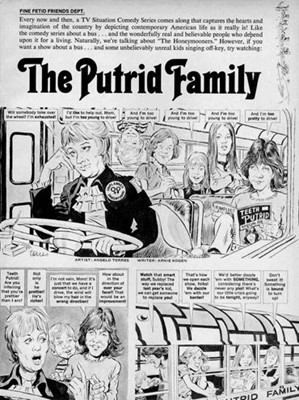
Imagine tolerating thatem> simple dismissal of your hard work when you were 22. And, you thought being a hugely popular teen idol was fun! To be fair, he has said that MAD parody was a “great piece” and “brilliant,” but it’s unclear if he was that enthusiastic about it in April ‘72.
Start With the “Hidden” Dave
But, using the best musicians around (many of whom were good friends, or became friends soon enough), he was able to share his musical gifts exactly the way he wanted in the ensuing decades. He should be lauded for that…in fact, he should be discovered anew, without the jaded and cynical press getting in your way.
Feel free to dig into his recorded output, 1975 and beyond. Not only do I think you’ll be pleasantly surprised, but I really think you’ll love him (all together, now: “He thinks you’ll love him”)!
Start with his official site, or begin with his little-heard 1985 album, Romance, released virtually everywhere on the planet (this one) EXCEPT the US! Yep, it saw the light of day in Japan, and Europe, including Germany, and to his forever-loyal fans in the UK. (in fact, by this point, Dave had actually relocated to England).
He landed Brit Alan Tarney (a-ha’s “Take on Me,” plus early ‘80s albums by Leo Sayer and Cliff Richard) to produce, and even got George Michael to sing background vocals on “The Last Kiss.” And, there are so many others.
